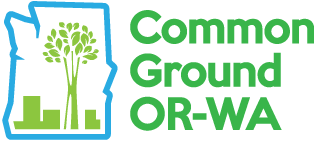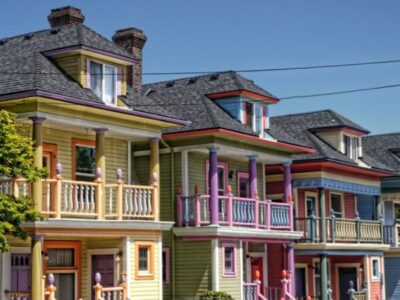Original Paper
Public Banking Could Create An Opportunity to Advance Portland City’s Affordability Policies
A Bank of Oregon Will Provide Cost-burdened Homeowners Assistance to Construct Accessory Dwelling Units
May 2020
The problem of unequal financial burden.
In early 2019 Common Ground OR/WA engaged the Northwest Economic Research Center (NERC) at Portland State University to conduct a study of the effects of land value taxation in two contrasting Portland communities. The NERC study clearly reveals inequities caused by the tax assessment limitation mandated by Measure 50 that have compounded over the past 22 years. Among the parcels analyzed in the Inner Northeast (INE), the maximum assessed value (MAV) is only 29 percent of real market value (RMV); in Outer Southeast (OSE), the MAV/RMV ratio is a higher 55 percent – closer to true market value. This means OSE properties that have grown in real value at a slower rate are subject to a higher effective tax rate ($12.17 per 1,000 MAV) under the current tax system than INE properties ($7.29 per 1,000 MAV). For example, a $500,000 home at maximum assessed value located in INE is subject to a property tax of about $4,700; an equivalent property located in OSE would experience a tax of about $6,000. Property owners in OSE are making up the difference for the below market-based tax levies owed by INE owners.
This inequity is particularly burdensome to OSE households for the following two reasons. First, a large proportion of the residents are lower-income households formerly displaced by rising housing costs in neighborhoods closer to the city center. Furthermore, much of this community was originally developed as semi-rural when lots were platted for septic sewer systems. OSE is characterized by modest houses on large lots, where the average lot size exceeds 9,000 square feet. Typical inner-city lots are platted at less than 5,000 square feet. Mean floor area ratios (FAR) are .16 on OSE single-family parcels compared to .36 on INE parcels, indicative of low land utilization.
Reverting to RMV assessments will help shift tax burdens away from low-value communities like OSE, but this alone does not solve the universal problem caused by the equal rate tax system. Taxing land and improvements at the same rate produces perverse incentives – to withhold capital investments in buildings and to hold land for speculative gain. The land value tax (LVT), on the other hand, is conceived to produce desirable incentives – to invest in substantial property improvements rather than speculate on sites and raise the costs for later occupants. In the U.S., the model for LVT is found in Pennsylvania cities that place a high tax rate on land and a low rate on improvement values. The NERC study concluded that RMV assessments coupled with separate rates on land and improvement values result in a significantly more balanced rate distribution than the present Oregon tax system. Furthermore, an LVT system would be slightly income progressive.
Nevertheless, the high land-to-improvement value ratio expected on large lots with modest houses could propel an upward tax shift when changing to the LVT system. How to correct the inequities of the existing tax system and mitigate the potentially large number of hardship cases in communities like OSE? The logical solution is to reverse the assessment ratio by investing in building upgrades or new infill construction. This will raise the improvement-to-land ratio and reduce tax burdens. But this resolution only works with the LVT split rate system. Under the current system, taxes will increase by making major structural improvements such as adding accessory dwellings to the tax roll. Up until 2016, county assessors applied the ill-advised property change ratio (PCR) that caused a jump in MAV closer to full market value. Then the Oregon Department of Revenue issued a draft rule whereby the tax increase for properties with new ADUs will depend on the county’s assessment of the contributory value of the ADU. Still, the tax incentive is contrary to public policy, and furthermore, property owners like those in OSE are least able to afford such investments.
The ADU Option
How can we turn this dilemma into a favorable outcome? Reviewing the existing conditions that can be leveraged to solve the problem: 1) a surplus of serviced land on private lots; 2) the need for income generation to strengthen homeowners’ financial solvency; 3) the general need for more low-income housing units for renters. Fortunately, Oregon state legislators and local councils are stepping in to help fashion solutions. The passage of House Bill 2001 strikes down local bans on duplexes for every low-density residential lot in all cities with more than 10,000 residents and all urban lots in the Portland metro area. In cities of more than 25,000 and within the Portland metro area, the bill would further legalize triplexes, fourplexes, attached townhomes, and cottage clusters on some lots in all “areas zoned for residential use,” where only single-detached houses are currently allowed.
Outer southeast is sharply divided between two currently unaffordable housing types: rental apartments within large buildings, and modest houses on large lots. The proposition to integrate “missing middle” housing types into the fabric of single-family homes can potentially make both existing and new housing more affordable.
About 70 percent of the Portland metro area is zoned for single-family housing. With some of the fastest-rising rents in the country, the urban region has a severe shortage of affordable units. More local officials are adopting the view that more accessory dwelling units (ADUs) could help address this problem. The ADU model could help solve financial problems for both owners and renters. The economics of housing are driving owners to think about how to use their lot space more efficiently and generate supplemental income. The City of Portland has already created one of the most ADU-friendly policies in the country. By now, there are over 2,000 ADUs constructed in Portland, situated on two percent of single-family lots; yet, fully half of all lots could qualify for ADU development.
Current Portland city regulations governing ADUs contain three criteria: (1) total accessory building coverage must be equal or less than 15 percent of total lot area; (2) internal floor space must equal 75% or less of the principal home’s living area; OR (3) equal 800 square feet – whichever is less (Chapter 33.205 of the Portland Zoning Code). For analytical purposes, we shall add a minimum standard of 500 sq. ft. for ADU internal space, considering the necessity to provide sufficient rentable space to meet income generation expectations. It is assumed that all ADU living space is ground floor.
According to these criteria, 89 percent of all developed single-family parcels in OSE are eligible for building an ADU of standard size or greater; 69 percent of all parcels meet or exceed the 800 sq. ft. maximum ADU size. On average, the lot area available for building an ADU is 1,377 sq. ft. For comparison, only 12 percent of single-family parcels in INE meet or exceed the 800 sq. ft. maximum, and the average lot area available is 717 sq. ft. Clearly, the opportunity is there to take advantage of the ADU construction option in the lower value, lower-income outer southeast community.
Homeowner Loan Assistance
But financing an auxiliary housing unit is out of reach for many homeowners. In the Portland area the minimum cost of a 400 sq. ft. basement or garage internal conversion unit is about $80,000; a detached new construction unit could cost about $150,000. Aiding the effort, Portland city waived development impact fees for ADUs, lowering the financial barrier somewhat. Still, this is insufficient for lower-income owners such as reside in outer southeast. More direct financial assistance is needed.
For over twenty years some politicians and citizens have been calling for the creation of a Bank of Oregon, which would keep money in the state and invest in sustainable development. Public banking is distinguished from private banking in that its mandate begins with the public’s interest. Privately-owned banks, by contrast, have shareholders who generally seek short-term profits as their highest priority. Public banks are able to reduce taxes within their jurisdictions, because their profits are returned to the general fund, providing a new source of income for cities and states and a source of funding for projects such as infrastructure, renewable energy, and affordable housing.
Taking the Bank of North Dakota as a national model, several states are now proposing to put public money to work for the public good. The public banking movement in Oregon began in 2011 with the introduction of HB 2972 followed by HB 3452, creating a publicly owned bank that would partner with local banks and credit unions. The Working Families Party of Oregon was and still is a major proponent. In the 2019 session, Oregon state representatives considered a House bill that would create a self-contained state-chartered banking system for the cannabis industry.
Specifically, what is needed is a public source of low-interest loan funding for low and moderate-income homeowners applying for ADU permits. Portland city commissioner Chloe Eudaly has lent her voice to this need, saying “I’ve been hell-bent on coming up with some kind of loan product an average homeowner could access (for building ADUs)”. The NERC analysis estimates that 40 percent of outer southeast households are ‘cost-burdened’, spending more than 30 percent of their income on housing costs. Without construction loans these households could never participate in this promising solution to the housing crisis, simultaneously providing income support to remain in their homes, retaining their homeownership status, and contributing to the increase in the supply of affordable rental housing.
Community-based lending backed by a Bank of Oregon would certainly benefit home-owning households, but what about renters? The University of Pittsburgh Medical Center and Urban Redevelopment Authority of Pittsburgh are proposing a Small Landlord Fund, which will give qualified landlords of buildings under 5 units access to low-interest loans of $20,000 a unit or $60,000 an apartment building for renovations that will qualify the structures for the federal Section 8 program. There are requirements for landlords to be in the program, including promising to meet affordability guidelines — households below 80 percent of area median income — as well as a deed restriction.
Now is the time for public officials and community leaders to step up and advance the cause of public banking in Oregon. Common Ground – OR/WA is prepared to work with a coalition of organizations such as Portland Public Banking Alliance, Oregon Working Families Party, Portland 2020 Vision, Portland for Everyone, Portland Neighbors Welcome, Proud Ground, Welcome Home Coalition, Housing Oregon, ADU Academy/Earth Advantage, and key state legislators who have previously sponsored legislation to create a Bank of Oregon.
Sources:
-Legislative Revenue Office, “AV/RMV Around the State” (interpolated figures)
-Kol Peterson in News, Policy & Trends, “The Death of Detached ADUs in Portland and What To Do About (Part IV),” December 23, 2015
-City Lab, “Portland’s ‘Granny Flats’ get an Affordable Boost”, Laura Bliss, March 12, 2018
-Oregon Live, Public banking: State ownership offers a wealth of advantages, Opinion guest columnist John Nichols, Posted March 13, 2010; updated January 10, 2019
-Pittsburgh Business Times, October 15, 2019
Tom Gihring, Ph.D., is Research Director of Common Ground OR-WA
1 Comment
Pingbacks
-
[…] Public Banking Could Create an Opportunity to Advance Portland City’s Affordability Policies […]
[…] Public Banking Could Create an Opportunity to Advance Portland City’s Affordability Policies […]




